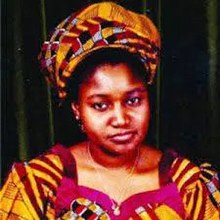Safinatu Buhari
Hajia Safinatu Buhari | |
|---|---|
 | |
| First Lady of Nigeria | |
| In role 31 December 1983 – 27 August 1985 | |
| Head of State | Muhammadu Buhari |
| Preceded by | Hadiza Shagari |
| Succeeded by | Maryam Babangida |
| Personal details | |
| Born | Safinatu Yusuf 11 December 1952 Jos, Northern Region, British Nigeria (now Jos, Plateau State, Nigeria) |
| Died | 14 January 2006 (aged 53) |
| Spouse | |
| Children | 5 |
Safinatu Buhari (née Yusuf) (11 December 1952 – 14 January 2006) was a Nigerian teacher and First Lady of Nigeria from 1983 to 1985. She was the first wife of Muhammadu Buhari.
Early life and education[edit]
Safinatu Yusuf was born on 11 December 1952 to Alhaji Yusufu Mani and Hajia Hadizatu Mani in Jos, Plateau State.[1] She was of the Fulani tribe of Northern Nigeria and hailed from Mani Local Government in Katsina State. She attended Tudun Wada primary school. Her family relocated to Lagos State when the then commissioner for Lagos affairs, Musa Yar'Adua appointed her father as his private secretary.[2]
She enrolled at the Women Teacher's Training College in Katsina and received a Grade 2 Teachers Certificate in 1971.[2] She was versed in Islamic education and was lettered in both English and Arabic.[3]
Personal life[edit]
She met Muhammadu Buhari at the age of 14 and they married in 1971 when she was 18.[2][4] They had 5 children namely; Zulaihatu (deceased), Magajiya-Fatima, Hadizatu-Nana, Safinatu Lami and Musa (deceased). When Muhammadu Buhari's government was overthrown by Ibrahim Babangida, she relocated to Kaduna with her children. Following the military coup that removed Muhammadu Buhari as president on August 27,1985, when he was released from prison, he divorced Safinatu shortly after; the reason for Buhari's divorce from his first wife has remained unknown. However, it is rumored that Safinatu was accused of receiving financial assistance from Babangida while her husband was imprisoned despite her husband's warning.[5]
Buhari, was diagnosed with diabetes in 1998.[5]
Her style was both traditional and minimal. It portrayed her ethnic origin.[6]
First Lady of Nigeria[edit]
Safinatu was the seventh First Lady of Nigeria from 31 December 1983 to 27 August 1985.[6][8] She was largely unknown by Nigerians as she did not have her own office or personal staff in Dodan Barracks. She stayed out of the public eye but took up responsibility hosting visiting First Ladies.[9][10][11]
Death[edit]
Buhari died 14 January 2006 as a result of diabetes-related complications at the age of 53.[7][6]
References[edit]
- ^ NewAfrican Life. IC Publications. 1990.
- ^ a b c Makori, Edwin Kwach (2020-11-05). "Safinatu Buhari biography: Who was Muhammadu Buhari's first wife?". Legit.ng - Nigeria news. Retrieved 2021-06-24.
- ^ Thandiubani; Thandiubani (2016-10-17). "The Thrilling Story About Safinatu, President Buhari's First Wife (Photo)". Tori.ng. Retrieved 2021-06-24.
- ^ Major-General Muhammadu Buhari: Profile. Federal Department of Information, Domestic Publicity Division. 1984.
- ^ a b Iroanusi, Sam (2006). Nigeria's First Ladies: Contributions to Nation-building. Sam Iroanusi. ISBN 978-978-2493-89-7.
- ^ a b c d "First Ladies of style". Punch Newspapers. 2017-10-01. Retrieved 2021-06-26.
- ^ a b Mueni, Priscillah (2020-10-23). "The rise to power of Muhammadu Buhari". Briefly. Retrieved 2021-06-24.
- ^ "Nigeria's First Ladies". THISDAYLIVE. 2020-10-02. Retrieved 2021-06-24.
- ^ Ogbuibe, Theresa (2002). Agents of Change: Gender and Development Issues. All Links of Harmony.
- ^ Sani, Hajo (2001). Women and National Development: The Way Forward. Spectrum Books. ISBN 978-978-029-282-9.
- ^ Mama, Amina (1995). "Feminism or Femocracy? State Feminism and Democratisation in Nigeria". Africa Development / Afrique et Développement. 20 (1): 37–58. ISSN 0850-3907. JSTOR 43657968.
